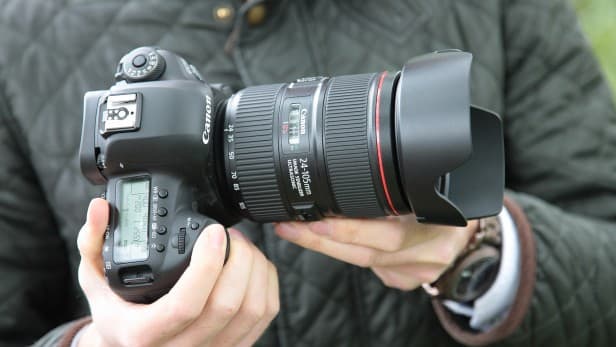This versatile full-frame EF mount zoom from Canon doesn’t disappoint, as part of the L-series line-up aimed at professionals, it features weather sealing, optical image stabilisation and an ultrasonic motor for fast and quiet autofocus, making it a fitting choice for photography and video recording too. Covering a wide 24-105mm focal range it is a great all-rounder that will make a handy addition to any photographer’s kit. For more options have a look at the best Canon EF lenses.
Canon EF 24-105mm f/4L IS II USM – At a glance
- Price: $1,299/£1,329
- Canon EF mount for full frame
- Image stabilization: OIS
- Aperture range: maximum f/4 – minimum f/22
- Minimum focus distance: 0,45m
- Filter size: 77mm
- Weight: 1 pound 12 ounces / 795g
When Canon announced the EOS 5D Mark IV in August 2016, the DSLR arrived on the scene at the same time as two full-frame optics: the EF 16-35mm f/2.8L III USM, and the revamped EF 24-105mm f/4L IS II USM, which we’re reviewing here.
Both lenses play a key role in Canon’s EF full-frame line-up. However, it’s the EF 24-105mm f/4L IS II USM that offers greater versatility, replacing a lens that was one of Canon’s best-selling full-frame lenses for the previous 10 years.
The original EF 24-105mm f/4L USM was a popular lens with Canon users for many different reasons. For those making the jump from an APS-C DSLR to full frame, it’s seen as one of the best multi-purpose lenses you can buy, plus there was often an incentive to buy it with a new Canon DSLR as part of a kit and save a considerable sum of money in the process.
What’s more, when you take its L-series status into consideration, you know that it’s been engineered to Canon’s highest standards and benefits from the type of build quality that will see it survive frequent and demanding use over many years.
The more recent EF 24-105mm f/4L IS II USM reviewed here has all this, along with an updated optical design and newer technology, making it an enticing choice for Canon DSLR users. Canon R-series mirrorless camera users on the other hand may like to investigate the RF 24-105mm F4L IS II USM ($1,299/£1,389), and RF 24-105MM F4-7.1 IS STM ($399/£479).
Canon EF 24-105mm f/4L IS II USM – Features
Favoured by those wanting to carry a single lens on location, the EF 24-105mm f/4L IS II USM falls into the standard zoom camp of premium lenses and differs from the original EF 24-105mm f/4L IS USM in a number of ways.
I’ll touch on the way it’s built to withstand the demands of professional use, with enhanced resistance to shock and vibration shortly, but let’s first outline what else it has to offer.

The lens features a revised optical design compared to its predecessor, which Canon claims improves resolution and edge-to-edge sharpness throughout the frame. Where the original lens featured an optical design of 18 elements in 13 groups with eight aperture blades, this newer lens incorporates 17 elements in 12 groups with 10 aperture blades.
You’d think that this would reduce the weight of the lens a little, but it’s actually slightly larger and heavier than its predecessor.
Modifying the optical construction has seen the maximum magnification increase slightly from 0.23x (at 105mm) to 0.24x (at 105mm). However, there’s no change to the minimum focusing distance, which remains at 0.45m.
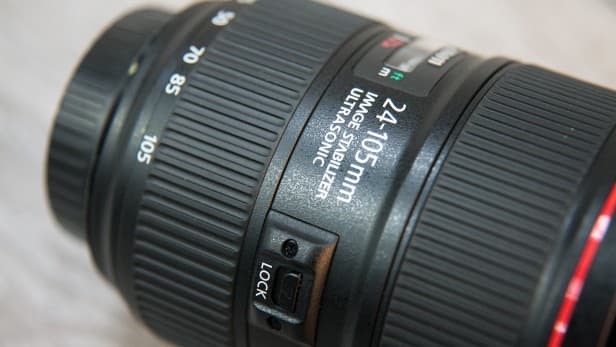
Elsewhere, the lens features Canon’s optical image stabilizer (OIS), which is specifically designed to counteract blur effects that are commonly associated with camera shake. The good news here is that the image stabilizer is now effective to 4 stops rather than 2.5, making it possible to achieve sharper handheld shots at slower shutter speeds.
Unlike many cheaper standard zooms, the maximum aperture remains at a constant f/4 right through the zoom range, but can be stopped down to a minimum of f/22.
In typical Canon fashion, the lens uses an ultrasonic motor to ensure autofocus is both fast and quiet. The full-time manual-focusing ring allows users to make fine focusing adjustments on the fly, without having to switch to manual mode first.

Canon has also ensured the lens provides smoother aperture changes during movie capture, by implementing a new electronic aperture diaphragm system (EDM).
As you’d expect for a lens that’s designed to be a standard go-to choice for many professional and enthusiast photographers, it includes weather sealing to prevent users from having to stow it away in adverse weather conditions.
At the rear of the lens there’s a rubber ring that compresses and effectively seals it against the camera’s metal lens mount.
Towards the front of the lens you’ll notice the famous red ring that’s synonymous with Canon’s premium L-series optics, and it accepts filters and adapter rings via a 77mm thread just like its precursor.
Canon EF 24-105mm f/4L IS II USM – Build and handling
As already mentioned, the EF 24-105mm f/4L IS II USM is heavier than the lens it sets out to replace. Not only does it weigh 125g more, it’s physically larger too.
The difference in length is most obvious when it’s viewed side by side with the original, and by being that little bit longer (11mm to be precise) it has allowed Canon to make the zoom and focus rings larger.
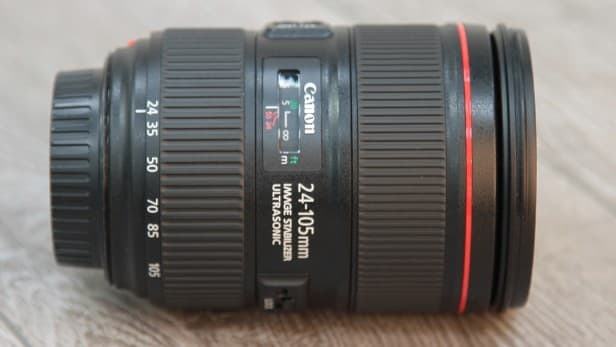
I didn’t encounter any difficultly locating or differentiating one ring from another from behind the camera on the older lens, but with this newer optic you do get slightly better purchase of them both.
The zoom ring operates across the focal range with a consistently smooth motion, and it never feels like you’re required to put more force into rotating it at one point than another.
When it’s used at the telephoto end, the front of the lens extends by approximately 40mm, but continues to feel well balanced with full frame DSLRs such as the EOS 5D Mark IV with which I tested it.
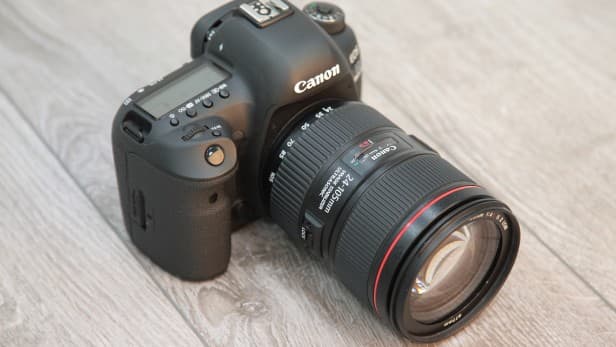
There’s nothing to prevent it being coupled to a Canon APS-C DSLR (equivalent to a 38-168mm lens). However, on smaller bodies such as the EOS 77D, it does make the camera feel quite nose-heavy and not as well balanced.
During the revamping process, Canon has updated the external design to match the look of other current L-series zooms such as the EF 24-70mm f/2.8L II USM. In the past, it’s always been fairly easy to tell the original 24-105mm lens apart from Canon’s latest 24-70mm fast aperture zoom; they now look very similar.
Compared directly with its predecessor, you’ll notice a number of small differences – such as the focal length markings being closer to the body of the lens, bolder white lettering, and the removal of the name of the lens at the front of the barrel, which is now printed beside the front element.

The design and position of the AF/MF and stabilizer switches remains much the same at the side, but whereas the stabilizer switch was slightly recessed on the older version, it isn’t on this newer version.
The manual focus ring provides a fluid and pleasing feel in use, and overall the lens meets the flawless build quality that one would expect from Canon and a lens that breaks the four-figure price barrier. You even get a lock switch to prevent the zoom extending beyond 24mm – but I rarely used it, since there was no sign of the zoom wanting to creep when it was pointing down.
Although the lens is compatible with the older EW-83H lens hood, users are advised to use the supplied EW-83M hood, which now locks into place to prevent it from being accidentally knocked off; it requires you to depress a small button to release it. Within the boxed contents you also get Canon’s latest style of lens cap and a compact lens pouch.
Canon EF 24-105mm f/4L IS II USM – Autofocus
When I tested this lens alongside the old version I found that it’s fractionally quieter when it goes about its business of focusing – however, it isn’t silent to the point that it rules out operational focusing noises being picked up by the built-in microphone during movie recording.

As for autofocus speed, I didn’t experience an obvious improvement between new and old, with each lens seemingly focusing as fast as the other between near and far subjects.
However, what has improved is the way the aperture can now be adjusted silently during movie recording, ruling out the pesky clicking sound you used to get on the older lens as the aperture blades moved.
Canon EF 24-105mm f/4L IS II USM – Image quality
Intrigued to find out how the lens’ new optical formula affects image quality, I took a number of comparison shots alongside my six-year-old version of the original lens.
I found the level of detail at the centre of the frame, at the widest end of the zoom range, to be comparable to results achieved with the older lens – and it was a similar story when I compared results half way through the zoom range.

Inspecting the corners of images taken throughout the zoom range at different apertures revealed that the new lens is a little sharper than its predecessor towards the edges. Plus, when I started to push to the far end of the zoom, I noticed that it resolves slightly finer detail in the centre with less chromatic aberration.
Further examination of identical shots confirmed that this new lens controls barrel distortion at the wide end of zoom slightly better, and although vignetting is present when it’s used at its widest aperture, it isn’t quite as severe as it is on the older lens.
After studying real-world examples, I referred to the lab results, which show the lens produces its sharpest results between the centre and edge of the frame at the middle of the zoom range. Stopping the lens down to f/5.6 or f/8 sees the centre sharpness improve at all focal lengths, and while corner sharpness never reaches the level of sharpness resolved at the centre, the lens is sharper towards the corner of the frame at the longer end of the zoom than it is at the wider end.

Those planning to regularly use the lens at the wide end are likely to find that the corners of images don’t appear as sharp as the centre, and you don’t gain a huge amount closing the lens down to f/5.6. Centre sharpness figures at f/11 are close to those recorded wide open at f/4, so for the sharpest results at any point in the zoom range you’ll want to use the lens between f/5.6-f/8. You’ll also notice that the impact of diffraction does soften overall sharpness when the lens is used at – or beyond – f/16.
When the lens is used at f/4, at both the wide end and long end of the zoom, the corners appear approximately 1EV darker than the centre. The good news is that corner shading quickly improves by stopping the lens down – and by the time you reach f/5.6, it’s barely evident. Users who shoot at f/4 can effectively remove vignetting by placing a tick in the ‘Enable Profile Corrections’ box within Camera Raw or Lightroom CC.
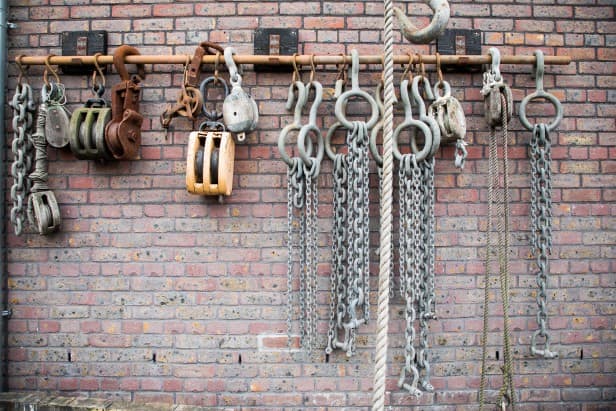
Lateral chromatic aberration is better controlled on this new lens, but green and purple fringing was still traceable and was corrected for effectively by enabling the ‘remove chromatic aberration’ option in Lightroom CC. With regards to distortion, the lens does exhibit barrel distortion at the wide end and pincushion distortion at telephoto lengths – but, again, this can be easily corrected during post-processing by applying the relevant lens profile.
Resolution
The lab results show that the lens performs best in the centre, with slightly sharper results being resolved at the centre of images towards the middle of the zoom range at f/4, than at the wide or longer end. Centre and edge sharpness improves by closing the lens down to around f/5.6 and f/8, which is to be considered the ‘sweet spot’ of the aperture range.
The lens resolves a similar level of sharpness in the corners at either end of the zoom when used at f/8. The impact of diffraction does soften overall sharpness, and this is most obvious when the lens is stopped down to f/16 or f/22.

Shading
Shoot at the maximum aperture of f/4 and you’ll notice that the corners of images appear darker than the centre by approximately 1EV. Corner shading does improve by stopping the lens down, and by the time you reach f/5.6, you’ll be hard-pushed to notice vignetting in real-world images. To remove the vignetting from our images taken at f/4, we enabled profile corrections from the lens corrections tab in Lightroom CC, which was very effective.

Canon EF 24-105mm f/4L IS II USM corner shading at 24mm, f/4
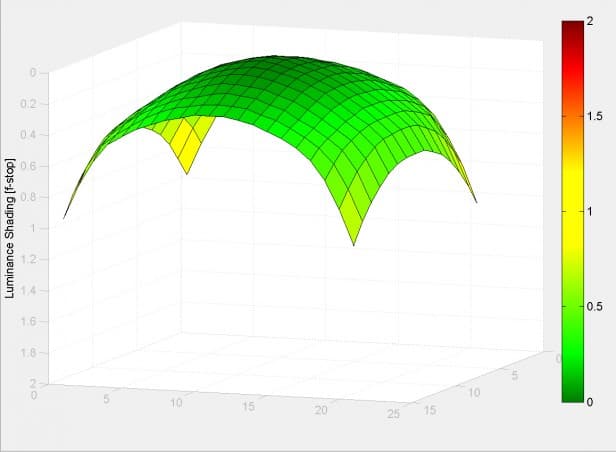
Canon EF 24-105mm f/4L IS II USM corner shading at 105mm, f/4
Curvilinear distortion
A study of our distortion chart reveals the lens exhibits barrel distortion at the wide end of the zoom, whereby straight lines towards the edge of the frame bow outwards. The amount of barrel distortion subsides as you extend the zoom, but starts to turn to pincushion distortion before 50mm. Although the distortion might not be immediately apparent in real-world shots, it becomes much more obvious when you enable profile corrections and turn it them on and off a few times.

Canon EF 24-105mm f/4L IS II USM @ 24mm, -2.4% TV SMIA

Canon EF 24-105mm f/4L IS II USM @ 50mm, 2.3% TV SMIA
Canon EF 24-105mm f/4L IS II USM – Verdict
The old EF 24-105mm f/4L IS USM had been due a revamp for a while, and the Canon EF 24-105mm f/4 L IS II USM is a better lens.
You always find that compromises have to be made when you opt for a zoom over a prime, but if you’re a Canon full-frame DSLR user who wants to carry around a single lens that covers a broad focal length range, this lens should be on your ‘to consider’ list.
Image quality has improved; however, those looking at it as an upgrade from the older lens shouldn’t expect a big difference in sharpness. Yes, it’s a touch sharper towards the corners, and was found to control vignetting and distortion slightly better, but I must admit image quality isn’t superior to the extent I was expecting.

The lens does present other benefits, and thanks to the improved four-stop image stabilisation system, I was able to shoot sharp handheld images with a 1/30sec shutter speed at the long end of the zoom. If you have a steady hand then it’s possible to attain sharp shots at the widest end of the zoom (24mm) using a 1/2sec shutter speed – something that isn’t possible on the older lens.
AF speed remains much the same, but the way the aperture can now be changed silently in Live View will benefit video users.
Simply put, the EF 24-105mm f/4 L IS II USM is the best full-frame standard zoom Canon has made covering this broad focal range, but if you feel you can make do without the extra reach it offers, want to benefit from a faster f/2.8 maximum aperture, and can stretch to the EF 24-70mm f/2.8L II USM ($1,699/£2,109), you’ll ultimately get a sharper lens in return that’s better tailored to your needs.

Further reading:
Follow AP on Facebook, Twitter, Instagram, YouTube and TikTok.

